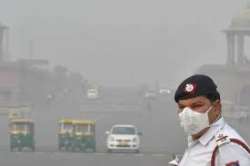This new computer model can predict India's pollution levels months earlier
With the 'smog season' in northern Indian states just a few months away, US and Chinese scientists have developed a novel computer model that can help accurately predict air pollution levels in the region a season in advance.

With the 'smog season' in northern Indian states just a few months away, US and Chinese scientists have developed a novel computer model that can help accurately predict air pollution levels in the region a season in advance.
The statistical model, described in the journal Science Advances, uses certain climatic patterns related to the ocean which have a regulatory effect on the wintertime air pollution over northern India.
India has emerged as one of the world's most polluted countries, with particulate matter (PM) 2.5 levels spiking over 500 microgrammes per cubic metre in Delhi and many other north Indian states last year.
According to the State of Global Air 2019 report published earlier this year, over 1.2 million people died in India due to air pollution in 2017.
The new model could allow the government to forecast aerosol pollution conditions in winter and accordingly improve plans for pollution control, researchers said.
"We built a statistical prediction model, which uses two autumn temperature variation patterns as predictors. With it, we will know air pollution in winter," said Meng Gao from School of Engineering and Applied Sciences, Harvard University in the US.
"In autumn, we have these indices calculated based on sea surface temperature and geopotential height fields, then the built model will tell you if the wintertime air pollution is severe or not,” Gao told PTI.
The researcher noted that India's neighbour China is making every effort to control air pollution, and India has emerged as the world’s most polluted country, receiving worldwide attention with frequent winter haze extremes.
The study found that the inter-annual variability of wintertime aerosol pollution over northern India is regulated mainly by a combination of El Nino -- a climate cycle in the Pacific Ocean with a global impact on weather patterns -- and the Antarctic Oscillation (AAO), a low-frequency mode of atmospheric variability of the southern hemisphere.
"There is no such study for India that tells you what will happen for India as much as a season in advance. This study also tells you the dominant climate factor for Indian air pollution, which has not been done before," said Gao, who is also associated with Hong Kong Baptist University in China.
Both El Nino sea surface temperature (SST) anomalies and AAO-induced anomalies can persist from autumn to winter, offering prospects for a pre-winter forecast of wintertime aerosol pollution over northern India, researchers wrote in the research paper.
The researchers, including those from Fudan University and Nanjing University of Information Science and Technology in China constructed a multivariable regression model incorporating El Nino and AAO indices for autumn to predict wintertime AOD.
The prediction exhibits a high degree of consistency with observation, they noted.
In his previous study, Meng highlighted the importance of power plant and residential emissions for health burden of air pollution in India.
He said in order to alleviate the problem of air pollution, India could make efforts first in these two sectors.
"They can use renewable production of electricity (wind, solar, etc) to replace coal-fired power plants, and reduce the usage of household cooking," said Meng.
He said that India should learn from Chinese government on how to implement policy.
"But on specific policy, high quality research is needed for India as the conditions for these two countries are different. Indian government can increase funding in field as China did before," he added.